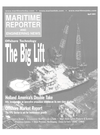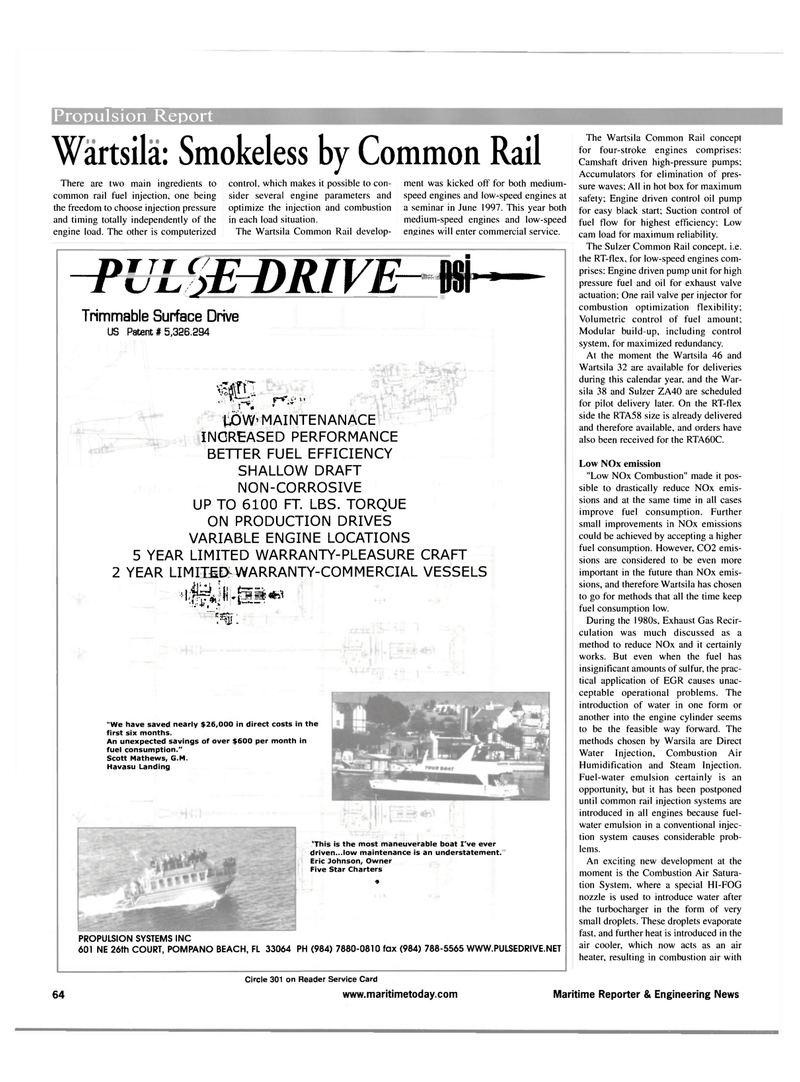
Page 64: of Maritime Reporter Magazine (April 2001)
Read this page in Pdf, Flash or Html5 edition of April 2001 Maritime Reporter Magazine
Propulsion Report
Wartsila: Smokeless by Common Rail
There are two main ingredients to common rail fuel injection, one being the freedom to choose injection pressure and timing totally independently of the engine load. The other is computerized control, which makes it possible to con- sider several engine parameters and optimize the injection and combustion in each load situation.
The Wartsila Common Rail develop- ment was kicked off for both medium- speed engines and low-speed engines at a seminar in June 1997. This year both medium-speed engines and low-speed engines will enter commercial service. puwnmvE M—
Trimmable Surface Drive
US Patent # 5,326.294
US r% r^F 0\N MAINTENANACE
INCREASED PERFORMANCE
BETTER FUEL EFFICIENCY
SHALLOW DRAFT
NON-CORROSIVE
UP TO 6100 FT. LBS. TORQUE
ON PRODUCTION DRIVES
VARIABLE ENGINE LOCATIONS 5 YEAR LIMITED WARRANTY-PLEASURE CRAFT 2 YEAR LIMITED WARRANTY-COMMERCIAL VESSELS ^Iilbs* : * m: "We have saved nearly $26,000 in direct costs in the first six months.
An unexpected savings of over $600 per month in fuel consumption."
Scott Mathews, G.M.
Havasu Landing 'This is the most maneuverable boat I've ever driven...low maintenance is an understatement.
Eric Johnson, Owner
Five Star Charters *
PROPULSION SYSTEMS INC 601 NE 26th COURT, POMPANO BEACH, FL 33064 PH (984) 7880-0810 fax (984) 788-5565 WWW.PULSEDRIVE.NET
The Wartsila Common Rail concept for four-stroke engines comprises:
Camshaft driven high-pressure pumps;
Accumulators for elimination of pres- sure waves; All in hot box for maximum safety: Engine driven control oil pump for easy black start; Suction control of fuel flow for highest efficiency; Low cam load for maximum reliability.
The Sulzer Common Rail concept, i.e. the RT-flex, for low-speed engines com- prises: Engine driven pump unit for high pressure fuel and oil for exhaust valve actuation; One rail valve per injector for combustion optimization flexibility;
Volumetric control of fuel amount;
Modular build-up, including control system, for maximized redundancy.
At the moment the Wartsila 46 and
Wartsila 32 are available for deliveries during this calendar year, and the War- sila 38 and Sulzer ZA40 are scheduled for pilot delivery later. On the RT-flex side the RTA58 size is already delivered and therefore available, and orders have also been received for the RTA60C.
Low NOx emission "Low NOx Combustion" made it pos- sible to drastically reduce NOx emis- sions and at the same time in all cases improve fuel consumption. Further small improvements in NOx emissions could be achieved by accepting a higher fuel consumption. However, C02 emis- sions are considered to be even more important in the future than NOx emis- sions, and therefore Wartsila has chosen to go for methods that all the time keep fuel consumption low.
During the 1980s, Exhaust Gas Recir- culation was much discussed as a method to reduce NOx and it certainly works. But even when the fuel has insignificant amounts of sulfur, the prac- tical application of EGR causes unac- ceptable operational problems. The introduction of water in one form or another into the engine cylinder seems to be the feasible way forward. The methods chosen by Warsila are Direct
Water Injection, Combustion Air
Humidification and Steam Injection.
Fuel-water emulsion certainly is an opportunity, but it has been postponed until common rail injection systems are introduced in all engines because fuel- water emulsion in a conventional injec- tion system causes considerable prob- lems.
An exciting new development at the moment is the Combustion Air Satura- tion System, where a special HI-FOG nozzle is used to introduce water after the turbocharger in the form of very small droplets. These droplets evaporate fast, and further heat is introduced in the air cooler, which now acts as an air heater, resulting in combustion air with 64
Circle 301 on Reader Service Card www.maritimetoday.com Maritime Reporter & Engineering News

 63
63

 65
65
